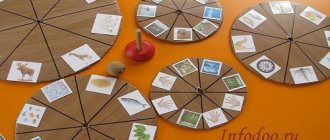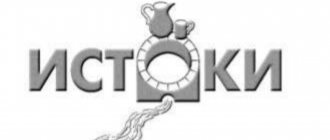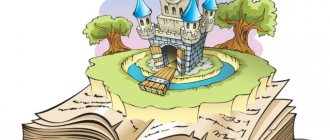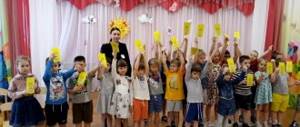Extracurricular activity program in fine arts “Palette” for students in grades 1–4
Galina Suvorova
Extracurricular activity program in fine arts “Palette” for students in grades 1–4
EXPLANATORY NOTE
The “Palette” program was developed for classes in the afternoon in accordance with the new requirements of the Federal State Educational Standard for primary general education of the second generation. In the process of developing the program, the main guideline was the goal of forming a harmonious, comprehensively developed personality, distinguished by uniqueness and originality with the help of the artistic and aesthetic direction of extracurricular activities in education. This direction, along with other types of art, prepares students to understand artistic images and introduces them to various means of expression. Based on aesthetic knowledge and artistic experience, students develop an attitude towards their own artistic activity, since creativity is one of the significant qualities of a person. Creative inspiration is a human need in which a person finds happiness. Experiencing spiritual satisfaction from what he creates, a person truly feels that he is living. Creativity gives birth to a living fantasy and a vivid imagination in a child. Creativity, by its nature, is based on the desire to do something that has never been done before, or, although something that existed before you, to do it in a new way, in your own way, better. In other words, creativity in a child is always a striving forward, for the better, for progress, for perfection and, of course, for beauty. This is the kind of creativity that is nurtured in a child. Without creative imagination, which we are trying to develop in a child, we cannot move forward in any area of human activity. This determines the relevance of this program. The new living conditions in which modern students are placed require them to be thoughtful, proactive, independent, and develop their own new original solutions; be focused on better end results.
The realization of these requirements requires a person with creative abilities. Characterizing the relevance of the topic, we see that the problem of creativity is of particular importance; abilities of children, the development of which acts as a kind of guarantee of the socialization of the child’s personality in society.
Primary school age is the beginning of a conscious perception of the world, when the criteria for aesthetic and spiritual beauty are laid down. Young schoolchildren become familiar with many types of creativity during art lessons, and in extracurricular activities they supplement their knowledge with new technologies and use non-traditional methods of depiction.
A child with creative abilities is active and inquisitive. He is able to see the unusual, the beautiful where others do not see it; he is able to make his own independent decisions, independent of anyone, he has his own view of beauty, and he is able to create something new, original. This requires special qualities of the mind, such as observation, the ability to compare and analyze, combine and model, find connections and patterns, etc. - all of which together constitute creative abilities. Artistic creativity helps change a child’s attitude to the process of cognition, develops a breadth of interests and curiosity, which “are the basic guidelines of federal educational standards.”
By creating their works, students acquire certain aesthetic tastes. Drawings created by children delight everyone around them. The result of these exciting activities is not only concrete - drawings, but also invisible to the eye - the development of subtle observation, spatial imagination, and non-standard thinking.
In extracurricular activities, much more than in the classroom, conditions are created for the development of individual inclinations, interests, and inclinations of students, and extracurricular work itself, designed to take into account the personal needs of the student, strives to satisfy them and requires a differentiated and individual approach to learning.
Goal and objectives of the program
Goal: expansion and deepening of knowledge, development of interest, introduction to independent creativity, disclosure of new abilities of students in the field of creativity through artistic and visual means.
Tasks:
1. To introduce children to various types of visual activities, the variety of artistic materials and techniques for working with them, to consolidate acquired skills and abilities and to show children the breadth of their possible application.
2. Development of cognitive interest, abilities, aesthetic needs and artistic and creative activity of students.
3. Development of artistic taste, creativity and imagination of children.
4. Improving motor skills, plasticity, flexibility of the hands, developing the accuracy of the eye.
5. Maintaining children's interest in visual arts through a situation of success.
6. Fostering mastery, a sense of beauty and harmony, hard work and responsibility.
7. Formation of sustainable interest in artistic activity.
8. Foster a desire for reasonable organization of your free time. Help children in their desire to make their work socially significant.
Forms and mode of classes
To implement the program, the main form is used - a lesson consisting of parts:
The introductory part of the lesson - the teacher introduces students to safety precautions, features of the organization of training and the proposed work technique for subsequent classes.
The introductory part of the lesson - the teacher introduces children to new methods of working in certain techniques with various materials.
The practical part of the lesson - the teacher monitors the work of each student and provides children with individual assistance.
The final part of the lesson - sums up the children's work completed during the lesson. It can take place in the form of mini-exhibitions and viewings of creative works.
PROGRAM CONTENT
Topic No. 1 “Colorful mood” - safe work conditions (introduction to the educational program). Acquaintance with various options and methods of depicting familiar compositions. Transformation from ordinary to amazing and unique. Making a spot-imprint using the monotype technique. Adding a colorful spot.
Mixed technique - drawing with wax crayons and covering with watercolors.
Completing tasks: “Festive bouquet”, “Colors of summer”.
Dot decoration - drawing with colored pencils, gel pens, felt-tip pens
(children's choice).
Completing tasks: “Autumn Flower”.
Drawing with charcoal - getting to know a new technique, shading the drawing.
Completing tasks: “Dense Forest”, “Spider and Web”, “Owl - Owl”.
Monotype – obtaining a print in a mirror image.
Completing tasks: “The Bottom of the Sea”, “The Enchanted World”.
Topic No. 2 “Art around us” - drawing as a direct form of art. The ability to mix paints and create beautiful color spots. Familiarity with different types of graphics and their characteristic features (stroke, line, contrast of black and white).
Blotography - methods of drawing with blots.
Complete tasks: “Transformation of a Blot”, “Butterfly Doll”.
The technique of pointelism is the creation of an image using only dots.
Completing tasks: “Magic Glades”, “World of Insects”.
Scratching - scratching a drawing.
Completing tasks: “Winter Landscape”, “Space”.
Drawing with cotton swabs - drawing a picture with a poke.
Completing tasks: “Snowflakes”.
Mixed technique - drawing with wax crayons and covering with gouache.
Completing tasks: “Fireworks”, “New Year tree”.
Topic No. 3 “The master’s work is afraid” - introduction to the basic laws of decorative painting. Stylization of natural forms. The role of the crumpled paper technique in shaping children's interest in artistic creativity and in the development of fine motor skills.
Stained glass technique - painting with special paints on a transparent surface (cup, cover).
Completing tasks: “Everyone is a master in his own way”, “Patchwork rug”.
Spraying technique is a method of applying with a brush or hard brush.
Completing tasks: “Snow colors”.
Mixed media - different techniques for working with tools and materials.
Completing tasks: “Valentine”.
The crumpled paper technique is drawing with crumpled paper.
Completing tasks: “Drawing a snowman.”
Decorative drawing - drawing elements of paintings: Gzhel, Khokhloma, Gorodets, haze.
Completing tasks: “Gzhel painting”, “Khokhloma painting”, “Gorodets painting”, “Dymkovo painting”.
Topic No. 4. “Creative workshop” - development of fine motor skills, preparation of children's fingers for more complex actions. Patterns as a means of decoration. Patterns created by nature (snowflakes, ice patterns on glass). Patterns created by the artist. Expressive possibilities and variety of patterns.
Drawing with paints - the visual properties of watercolors. Primary colors.
Completing tasks: “A good fairy tale.”
Ornament - rhythm. Ornament in a circle. Gouache. Practicing the technique: mixing color with white.
Completing tasks: “Fairy-tale composition”, “Patterned snakes”.
Drawing with pencils - conveying the shape, outline and color of the animals depicted.
Completing tasks: “Fantastic Animal.”
Drawing with wax crayons is the creation of creative work based on your own ideas using art materials.
Completing tasks: “Spring Day”.
Topic No. 5. “Vernissage” - viewing the creative works of students and discussing the results of the work during the work of the circle. Computer presentations, photographic works. Organization of exhibitions of works at the end of the circle’s activities.
Performance:
Personal exhibitions.
Creating a creative portfolio.
Organization of exhibitions of works at the end of the year - “Our Museum”.




